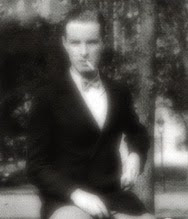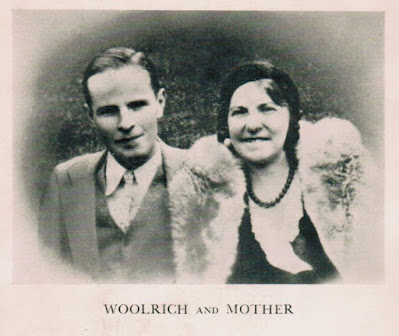The Ten Faces of Cornell Woolrich was a 1965 collection of short stories, one of two Cornell Woolrich short story collections published that year (the other being The Dark Side of Love). It was distinguished with an introduction by Fred Dannay of Ellery Queen, who wrote rather arbitrarily that Woolrich's
ninth face....is really a mask. For what do we know of the man inside?....Woolrich is retiring almost to the point of being a recluse. When we add up all we know, we know very little, and Woolrich is reluctant to reveal his inner self....
The Ten Faces title was really metaphorical (and the conceit rather forced), causing Dannay to struggle in his introduction, although his observation above was perceptive. Here I take the opportunity to show you ten actual faces of Cornell Woolrich, arranged as chronologically as I can get them from fresh youth in the Twenties to worn age in the Sixties. As Barry Malzberg has written, in the last year of his life Woolrich was sixty-four but looked eighty-four.
 |
| FACE 1 1925 photo of Woolrich, when he was 21 years old and still in college at Columbia University. Contemporaries continually described him as boyish, pale, hollow-cheeked, shy and sickly. |
 |
| FACE 2 Cornell in college? The blurry image is symbolic of an elusive man |
 |
| FACE 3 Cornell Woolrich at the time he went Hollywood, 1927-30, when he was employed as a screenwriter |
 |
| FACE 5 This banner story ran in newspapers across the country in 1933 after Bill filed her annulment suit in Manhattan in 1933. See my recent Crimereads article. The picture of Woolrich used appears to have been a rendering of his earlier 1925 photo, making him look younger than he did in 1933. |
 |
| FACE 7 Woolrich in the late 1950s, another book jacket photo, I believe, an iconic mid-century image |
 |
| FACE 8 1958 book jacket photo Woolrich made the effort to spruce himself up here, but compare to the 1925 photo and you see a huge change, although the paleness and sunken cheeks are the same. |
 |
| FACE 9 you can see his decline |
 |
| FACE 10 Woolrich near the end |




Interesting! I am a huge Cornell Woolrich fan. That last picture is a hoot!
ReplyDeleteIt's Woolrich not Woolrich!
DeleteGreat writer. I need to revisit his work.
ReplyDeletePicture #7 is indeed a great picture.
ReplyDeleteYeah he doesn't look so annihilated in that one.
DeleteSome wonderful photo finds, and (since you linked to it) a wonderful article, too! Trying to read in between the lines of what Nevins (and Trimble) said about the marriage, I always wondered if the real reason it failed was more due to some unholy combination of unrealistic expectations and bad communication, which ultimately resulted in a lot of hurt feelings (and mistaken/vengeful assumptions). Which still might very well have been the case, but I was definitely not expecting all the extra drama on top! I don't like to go around casting apersions on other women, but...uh...it does indeed seem like "Bill" used the annulment as a publicity stunt, doesn't it?
ReplyDeleteInterestingly enough, I've read The Smart Set article in its entirety (thank you, archive.org), and while it does have a surface vibe of, "UGH, modern women and their swearing and sex and forwardness!", I kind of get the impression that what Woolrich was really frustrated with was the superficiality of the era. It seems to me that he wasn't longing for an "old-fashioned" girl, so much as someone he could just have a true connection with (and unfortunately he maybe didn't word this as well as he could have? hence the backlash?). But, like, he outright says at the end that he doesn't care how much a gal smokes or how she dresses, that it's an "old-fashioned heart" he's really interested in, so...take that for what you will, I guess. It's a neat look into the culture of the time, if nothing else.
To bring it back to Nevins for a moment, I've started to dip my toes into the 1988 biography to see for myself what it says, and...uh...wow. Even ignoring all the stuff about Woolrich's sexuality, Nevins makes so many suspect statements/interpretations that I find myself side-eyeing the book more often than not. (LOTS of grains of salt on hand when I'm reading it, to say the least.) It honestly makes me wonder how it was ever critically acclaimed, and the only thing I can think of is that it was a case of beggars not being able to be choosers, as there was so very little information out there about Woolrich at the time. Suffice it to say, your Crime Reads article was a breath of fresh air, and I can only hope it gets the attention it deserves. So thanks again for the Woolrich content and the great read!
Thank you for this comment, so sorry I missed at the time.
Delete